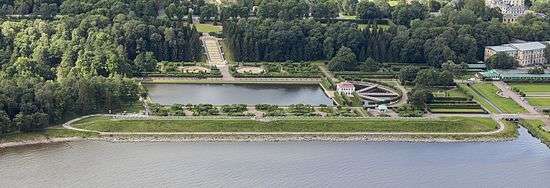Peterhof Palace

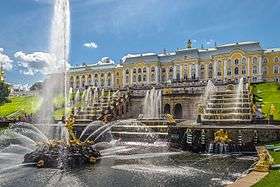
The Peterhof Palace (Russian: Петерго́ф; IPA: [pʲɪtʲɪrˈɡof],[1] Dutch for Peter's Court)[2] is a series of palaces and gardens located in Petergof, Saint Petersburg, Russia, laid out on the orders of Peter the Great. These palaces and gardens are sometimes referred as the "Russian Versailles". The palace-ensemble along with the city center is recognized as a UNESCO World Heritage Site.
Layout
The dominant natural feature of Peterhof is a sixteen-metre-high bluff lying less than a hundred metres from the shore. The so-called Lower Gardens (Nizhny Sad), at 1.02 km² comprising the better part of Peterhof's land area, are confined between this bluff and the shore, stretching east and west for roughly 200 metres. The majority of Peterhof's fountains are contained here, as are several small palaces and outbuildings. East of the Lower Gardens lies the Alexandria Park with 19th-century Gothic Revival structures such as the Kapella.
Atop the bluff, near the middle of the Lower Gardens, stands the Grand Palace (Bolshoi Dvorets). Behind (south) of it are the comparatively small Upper Gardens (Verhnyy Sad). Upon the bluff's face below the Palace is the Grand Cascade (Bolshoi Kaskad). This and the Grand Palace are the centrepiece of the entire complex. At its foot begins the Sea Channel (Morskoi Kanal), one of the most extensive waterworks of the Baroque period, which bisects the Lower Gardens.
The Grand Cascade and Samson Fountain
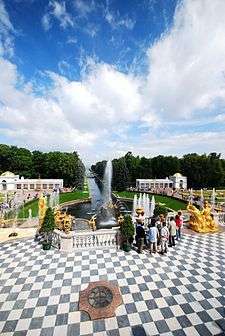
The Grand Cascade is modelled on one constructed for Louis XIV at his Château de Marly,[3] which is likewise memorialised in one of the park's outbuildings.
At the centre of the cascade is an artificial grotto with two stories, faced inside and out with hewn brown stone. It currently contains a modest museum of the fountains' history. One of the exhibits is a table carrying a bowl of (artificial) fruit, a replica of a similar table built under Peter's direction. The table is rigged with jets of water that soak visitors when they reach for the fruit, a feature from Mannerist gardens that remained popular in Germany. The grotto is connected to the palace above and behind by a hidden corridor.
The fountains of the Grand Cascade are located below the grotto and on either side of it. There are 64 fountains.[4] Their waters flow into a semicircular pool, the terminus of the fountain-lined Sea Channel. In the 1730s, the large Samson Fountain was placed in this pool. It depicts the moment when Samson tears open the jaws of a lion, representing Russia's victory over Sweden in the Great Northern War, and is doubly symbolic.[5] The lion is an element of the Swedish coat of arms, and one of the great victories of the war was won on St Samson's Day. From the lion's mouth shoots a 20-metre-high vertical jet of water, the highest in all of Peterhof. This masterpiece by Mikhail Kozlovsky was looted by the invading Germans during the Second World War; see History below. A replica of the statue was installed in 1947.
Perhaps the greatest technological achievement of Peterhof is that all of the fountains operate without the use of pumps. Water is supplied from natural springs and collects in reservoirs in the Upper Gardens. The elevation difference creates the pressure that drives most of the fountains of the Lower Gardens, including the Grand Cascade. The Samson Fountain is supplied by a special aqueduct, over four km in length, drawing water and pressure from a high-elevation source.
The Lower Gardens

The expanse of the Lower Gardens is designed in the formal style of french formal gardens of the 17th century. Although many trees are overgrown, in the recent years the formal clipping along the many allees has resumed in order to restore the original appearance of the garden. The many fountains located here exhibit an unusual degree of creativity. One of the most notable designs is entitled 'The Sun'. A disk radiating water jets from its edge creates an image of the sun's rays, and the whole structure rotates about a vertical axis so that the direction in which the "sun" faces is constantly changing.
Several fountains are designed with the specific purpose of soaking visitors. Two take the form of gangly trees rigged with jets that activate when someone approaches. Another, disguised as an umbrella with a circular bench set around the stem, drops a curtain of water from its rim when someone enters to take a seat.
The same bluff that provides a setting for the Grand Cascade houses two other, very different cascades. West of the Grand Palace is the Golden Mountain (Золотая Гора), decorated with marble statuary that contrasts with the riotous gilded figures of the Grand Cascade. To the east is the Chess Mountain (Шахматная Гора), a broad chute whose surface is tiled black and white like a chessboard. The most prominently positioned fountains of Peterhof are 'Adam' and 'Eve'. They occupy symmetric positions on either side of the Sea Channel, each at the conjunction of eight paths.
The Grand Palace

The largest of Peterhof's palaces looks truly imposing when seen from the Lower or Upper Gardens, but in fact it is quite narrow and not overly large. Of its approximately thirty rooms, several deserve mention.
The Chesma Hall is decorated with twelve large paintings of the Battle of Chesma, a stunning naval victory of the Russo-Turkish War, 1768-1774. These were painted between 1771 and 1773 by the German artist Jacob Philipp Hackert. His first renderings of the great battle scenes were criticised by witnesses as not showing realistically the effect of exploding ships — the flying timbers, great flames, smoke, and fireballs. Catherine II assisted the artist by exploding a frigate in the harbour of Livorno, Italy, for the benefit of Hackert, who had never seen a naval battle first-hand. Hackert also did not research the actual positions of the Russian and Turkish forces during the battle, so the scenes depicted are somewhat fanciful, but do effectively convey drama and destruction of naval warfare.
The East and West Chinese Cabinets were decorated between 1766 and 1769 to exhibit objects of decorative art imported from the East. The walls were decorated with imitation Oriental patterns by Russian craftsmen, and hung with Chinese landscape paintings in yellow and black lacquer. Another room, positioned at the centre of the palace, bears the name of the Picture Hall. Its walls are almost entirely covered by a series of 368 paintings, mostly of variously dressed women, differing in appearance and even age, yet most were drawn from a single model. These were purchased in 1764 from the widow of the Italian artist P. Rotari, who died in St. Petersburg.
Other features
Marli Palace in the lower garden area
The Grand Palace is not the only historic royal building in Peterhof. The palaces of Monplaisir and Marly, as well as the pavilion known as the 'Hermitage', were all raised during the initial construction of Peterhof during the reign of Peter the Great. The Lower Gardens also contain a large greenhouse, and in the Alexandrine Park stands the palace of Nicholas I.
Like the Lower Gardens, the Upper Gardens contain many fountains, distributed among seven broad pools. The landscaping, though, is entirely different; unlike the Lower Gardens (which are strictly geometric), the Upper Gardens are not. While a few of the fountains have curious sculpture, the waterworks themselves are comparatively unimpressive.
History
1705-1755
In the time of Peter the Great, the sea floor just north of the Peterhof site and to the east toward St. Petersburg was too shallow for either commercial ships or warships. However, to the west of Peterhof, the sea floor dropped off to be deep enough for sea vessels. Accordingly, when Peter the Great decided to build St. Petersburg at the eastern end of the Gulf of Finland, he first captured the Kotlin Island clearly visible from the Peterhof site just to the northeast in the middle of the Gulf. At Kotlin Island he would build the commercial harbour for St. Petersburg as well as the Kronstadt fortifications across the 20 kilometres of shallow sea to provision and defend the Navy that he would build.

Peter the Great first mentions the Peterhof site in his journal in 1705, during the Great Northern War, as a good place to construct a landing for use in travelling to and from the island fortress of Kronstadt. And in 1714, Peter began construction of the Monplaisir ("my pleasure") Palace based on his own sketches of the palace that he wanted close to the shoreline. This was Peter's Summer Palace that he would use on his way coming and going from Europe through the harbour at Kronstadt. On the walls of this seacoast palace hung hundreds of paintings that Peter brought from Europe[6] and allowed to weather Russian winters and the dampness of the sea without heat. In the seaward corner of his Monplaisir Palace, Peter made his Maritime Study, from which he could see Kronstadt Island to the left and St. Petersburg to the right.[7] Later, he expanded his plans to include a vaster royal château of palaces and gardens further inland, on the model of Versailles. The initial design of the palace and its garden was done by the French architect Jean-Baptiste Le Blond.[8] Each of the tsars after Peter expanded on the inland palaces and gardens of Peterhof, but the major contributions by Peter the Great were completed by 1725. Peter had also entertained plans of a similar palace at Strelna, a short way to the east, but these plans were abandoned.
Peterhof originally in the early 1700s appeared quite different from today. Many of the fountains had not yet been installed. The entire Alexandrine Park and Upper Gardens didn't exist. (The latter was used to grow vegetables, and its ponds, then numbering only three, for fish.) The Samson Fountain and its massive pedestal had not yet been installed in the Sea Channel, and the channel itself was used as a grand marine entrance into the complex.

Perhaps the most important change augmenting Peter's design was the elevation of the Grand Palace to central status and prominence. The Grand Palace was originally called simply 'Upper', and was hardly larger than any of the other structures of the complex. The addition of wings, undertaken between 1745 and 1755, was one of the many projects commissioned from the Italian architect Bartolomeo Rastrelli by Elizabeth of Russia.[9] Likewise, the Grand Cascade was more sparsely decorated when initially built. The augmentation of Peterhof's original fountains and the addition of new ones continued well into the 19th century.
1941 - Modern Day
Peterhof, like Tsarskoye Selo, was captured by German troops in 1941 and held until 1944. In the few months that elapsed between the outbreak of war in the west and the appearance of the German Army, employees were only able to save a portion of the treasures of the palaces and fountains. An attempt was made to dismantle and bury the fountain sculptures, but three quarters, including all of the largest ones, remained in place. The occupying forces of the German Army largely destroyed[10] Peterhof. Many of the fountains were destroyed, and the palace was partially exploded and left to burn. Restoration work began almost immediately after the end of the war and continues to this day. The Lower Park was reopened to the public in 1945.[11]
The name was changed to "Petrodvorets" ("Peter's Palace") in 1944 as a result of wartime anti-German sentiment and propaganda, but the original name was restored in 1997 by the post-Soviet government of Russia. In 2003, Saint Petersburg celebrated its 300th anniversary. As a result, much of the building and statuary in Peterhof has been restored and new gilt-work abounds.
The "purpose" of Peterhof was as a celebration and claim to access to the Baltic (while simultaneously, Peter the Great was also expanding on the Black Sea littoral). Thus Peterhof commemorates the imperial expansion (and modernization of Russia). Inside the Peterhof there are many paintings of sea battles by the famous Ivan Aivazovsky.
See also
- List of Baroque residences
- Medici lions; the inspiration for the palace's Lion Cascade
- Peter the Great Statue
- Historic Centre of Saint Petersburg and Related Groups of Monuments
- List of World Heritage Sites in Russia
Gallery
 Church of the Grand Palace
Church of the Grand Palace Poseidon and a dome at the palace
Poseidon and a dome at the palace Another view of the Grand Cascade
Another view of the Grand Cascade The Upper Gardens of Peterhof
The Upper Gardens of Peterhof The Hermitage Pavilion in the Lower Gardens
The Hermitage Pavilion in the Lower Gardens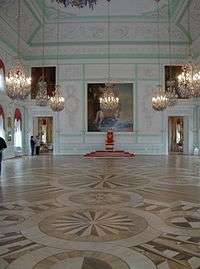 The Grand Throne Room
The Grand Throne Room Samson and the Lion, by Mikhail Kozlovsky
Samson and the Lion, by Mikhail Kozlovsky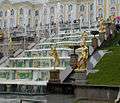 A portion of the Grand Cascade
A portion of the Grand Cascade- Aviary Pavilion
 Olgin Pavilion
Olgin Pavilion Tsaritsyn Pavilion
Tsaritsyn Pavilion
References
- ↑ ⟨h⟩ is commonly/historically transliterated into Russian as ⟨г⟩ (g), so German Peterhof is transliterated as "Петергoф" Petergof.
- ↑ Adrian Room, "Petrodvorets", Placenames of the world: origins and meanings of the names for over 5000 Natural Features, Countries, Capitals, Territories, Cities and Historic sites (1997)
- ↑ https://www.outdoorfountainpros.com/blogs/news/133089091-the-quizzical-trick-fountains-of-peterhof-palace
- ↑ http://www.saint-petersburg.com/peterhof/fountains-peterhof/
- ↑ http://stpetersburg-guide.com/history/petrodvorets.shtml
- ↑ "The Eastern Gallery". Peterhof State-Museum Reserve. Archived from the original on 2001-12-25.
- ↑ "The Maritime Study". Peterhof State-Museum Reserve. Archived from the original on 2006-10-03.
- ↑ R.K. Massie, Peter the Great: His life and world (New York: Ballantine Books, 1986), p. 631.
- ↑ http://www.saint-petersburg.com/peterhof/grand-palace/
- ↑ "Curating under Communism: 'A Historic Lesson for the Entire World' - SPIEGEL ONLINE". Spiegel.de. 2012-07-13. Retrieved 2013-08-11.
- ↑ http://www.saint-petersburg.com/peterhof/
Further reading
- King, Greg (2006). The Court of the Last Tsar. Hoboken: John Wiley & Sons. ISBN 978-0-471-72763-7.
- Vernova, N (2004). Peterhof: The Fountains. St. Petersburg: Abris.
- Vernova, N (2004). Peterhof: The Grand Palace. St. Petersburg: Abris.
External links
| Wikimedia Commons has media related to Peterhof. |
- Official website available in Russian or English.
- Map of Kronstadt in Russian and English showing the central Island of the Kronstadt fortifications and Naval yard that Peter the Great constructed across the shallow Gulf of Finland to control access by water to St. Petersburg after his armed forces took the area from Sweden in 1703. Peter built Peterhof on the southern shore with a clear view of the Kronstadt fortifications and Naval yard.
- Summary of the Peterhof location, including map showing the relative positions of Peterhof, Kronstadt, Gulf of Finland, and St. Petersburg.
- Interactive satellite view map of Kronstadt, Peterhof, and St. Petersburg. The Kronstadt Island harbor that Peter the Great built on what was Kotlin Island is in the middle of the Gulf of Finland. The Kronstadt fortifications in shallow water stretch east and south from Kronstadt Island. Peterhof ("Petrodvorets" on this map) is southeast of Kronstadt Island on the shore. St. Petersburg is to the east on the River Neva.
- Official page for Monplaisir Palace, the palace and personal retreat that Peter the Great designed and built for his own pleasure.
Coordinates: 59°53′N 29°54′E / 59.883°N 29.900°E
